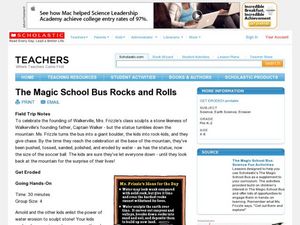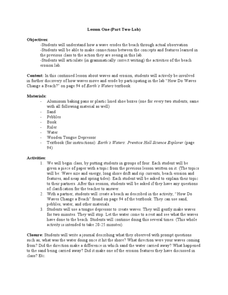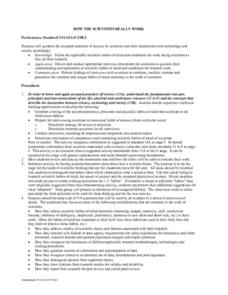Curated OER
The Greenhouse Effect in a Jar
Learners explore climate change by participating in a physical science experiment. In this greenhouse effect lesson plan, students discuss the impact global warming has on our environment and how it works. Learners utilize a glass jar,...
Curated OER
Understanding the Roots
Young scholars investigate the parts of a flower. For this earth science lesson, students read the book The Magic School Bus Plants Seeds and identify various plant parts. Young scholars construct a model of a flowering plant from...
Curated OER
The Magic School Bus Rocks and Rolls
Students participate in a science experiment to show them the power that water erosion has to sculpt stone. They explore how running water moves earth and creates new landforms.
Curated OER
Changing State
Students investigate the cooling and heating of water. In this online science experiment lesson, students work in groups to make predictions regarding freezing and boiling points and then test those predictions as they complete the...
Curated OER
Nature: Planting Terrariums
Students observe and experiment using a terrarium. In this scientific lesson plan, students build a nature terrarium. Students then observe their terrarium over a period of time to discover what makes the plants grow. A science...
Curated OER
The Greenhouse Effect
Seventh graders investigate the temperature change in open and closed containers. In this earth science lesson, 7th graders relate this lab activity to greenhouse effect. They create a line graph from data collected in the experiment.
Alabama Learning Exchange
The Ocean Floor
Learners explore the ocean in this earth science lesson. They use the Internet to gather information on parts of the ocean including the beach, ocean floor, continental shelf, trenches, and the animals that inhabit these parts.
Curated OER
Keep It Cool
Students complete a science experiment to study insulation, heat transfer, and permafrost. For this permafrost study lesson, students design and test a soda insulator. Students graph their class data and discuss the results. Students...
Curated OER
How We See Things
Learners explain that when a beam of light is reflected from its surface, it changes direction. In this virtual science experiment lesson plan, students complete an activity that requires them to investigate how flat mirrors reflect...
Curated OER
Characteristics of Energy
Students explore Earth science by completing energy worksheets in class. In this energy forms lesson, students identify and define a list of energy vocabulary terms and a K-W-L chart. Students view a matter video clip in class and...
Curated OER
Analyzing The Research Of The Earth
Students investigate the concept of technology. They are taught about various science applications and how the technology is used in the disciplines. Students pick a subject to research and then indicate the technologies related to it...
Curated OER
Understanding Lava Layers
Seventh graders trace the lava flow of an erupting volcano. In this earth science lesson, 7th graders experiment using baking soda and vinegar. They record and share their observations.
Curated OER
How Do Waves Change a Beach?
Students conduct an experiment on beach erosion. In this earth science lesson plan, students create a beach model and use tongue depressor to produce waves. They write a journal about their observations.
Curated OER
Rock Cycle
Students explain the processes involved in the rock cycle. In this earth science lesson, students identify the different kinds of rocks. They complete a worksheet during the activity.
Curated OER
Planets in a Bottle
Students experiment with yeast. For this environmental conditions lesson students test the viability of samples of yeast. Students investigate the effects of environmental conditions on the yeast.
Curated OER
Me and My Shadow
Students apply the process of scientific inquiries or technological design to explore the explanations of the daily patterns of the Earth's rotation. They record different shadow lengths showing the apparent movement of the sun through...
Curated OER
Water Cycle in a Box
Fourth graders investigate how the water cycle is vital for all living things to survive on Earth. They observe the teacher set up a simulation of the water cycle using a Plastic Earth Simulator, desk lamp, and water, and make...
Curated OER
Making Hail
Fourth graders investigate the different types of precipitation and conduct a hail experiment. They identify the types of precipitation during a slideshow, and define key vocabulary terms. Next, in small groups they follow the...
Curated OER
Trees and Erosion
Students examine the connection between trees and erosion. In this erosion lesson students experiment with the effects of rain on a hillside. Students investigate the number of trees and the amount of erosion.
Curated OER
Balloon Rockets
Students, after reviewing and analyzing Newton's third law of motion, make balloon rockets and experiment with a variety of models. After the experiment, they chart the results and form conclusions. In addition, they compare/contrast...
Curated OER
How The Scientists Really Work
High schoolers question the accepted practices of science by scientists and their interactions with technology and society. They devise and conduct appropriate interview procedures for scientists to question their understanding and...
Curated OER
Modeling the Rock Cycle
In this modeling the rock cycle worksheet, students use a sugar cube to show the phases and changes in the rock cycle as represented by the changes in the sugar cube. For each step of the experiment students indicate the part of the rock...
Curated OER
The Phantom of the Computer Lab
Learners calculate the power consumption of computers in school. In this physics lesson, students design an experiment to determine whether the school should unplug computers at the end of the day. They collect data and report findings...
Curated OER
Temperature and Tracking Weather
Fourth graders discuss, describe and track weather by utilizing a variety of measurable quantities as temperature, wind speed, wind direction, cloud conditions and precipitation. They assess, through experiments and practicing, how to...























